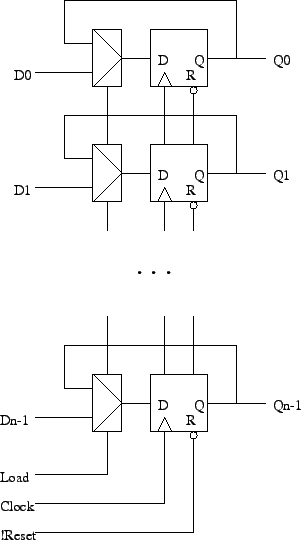Examples: register file, MDR, MAR.
Example: program counter.
Tom Kelliher, CS 240
Apr. 26, 2010
Homework due today!
Read 7-1-7-3, 7-6, 7-9.
VHDL for sequential circuits.
Shift registers.
Examples: register file, MDR, MAR.
Example: program counter.
Use a mux approach:

Gating the clock will save the muxes, but clock gating is usually a bad idea -- clock skew problems.
clockToFF = load and clock
clockToFF = !load or clock
Note: The handling of the load signal could be used to implement a synchronous reset.
-- VHDL for 32 bit parallel load register with asynchronous low
-- reset.
library ieee;
use ieee.std_logic_1164.all;
entity parallel_register is
port (
clock, load, reset_n : in std_logic;
d : in std_logic_vector (31 downto 0);
q : out std_logic_vector (31 downto 0));
end parallel_register;
architecture dataflow of parallel_register is
signal state : std_logic_vector (31 downto 0);
begin -- dataflow
q <= state; -- Output process.
state_reg : process (clock, reset_n)
begin -- process state
if (reset_n = '0') then -- asynchronous reset (active low)
state <= X"00000000";
elsif (clock'event and clock = '1') then -- rising clock edge
if (load = '1') then
state <= d;
else
state <= state;
end if;
end if;
end process state_reg;
end dataflow;